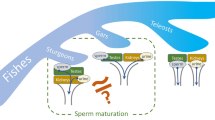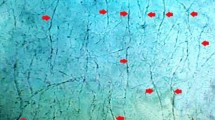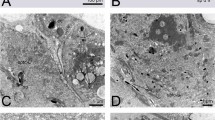Abstract
I HAVE already described1 the development of the reproductive organs in the male of the cockchafer (Melolontha melolontha L.) and the origin, development, and function of the spermatophore. The Spermatophore is formed in the copulatory sac of the male while it is inserted in the bursa copulatrix of the female. The contents of the genital duct (bundles of inactivated spermatozoa, cyst cells) and the secretion of the accessory glands (the hyaline component staining green with Masson's trichrome, a granular component staining red, and basophil droplets staining blue-violet) are expelled into the copulatory sac. Within three hours of copulation, the spermatophore is encased in a protein membrane and deposited in the bursa copulatrix.
This is a preview of subscription content, access via your institution
Access options
Subscribe to this journal
Receive 51 print issues and online access
$199.00 per year
only $3.90 per issue
Buy this article
- Purchase on Springer Link
- Instant access to full article PDF
Prices may be subject to local taxes which are calculated during checkout
Similar content being viewed by others
References
Landa, V., Acta Soc. Ent. Czechoslov., 56, 313 (1959); 57, 297 (1960).
Author information
Authors and Affiliations
Rights and permissions
About this article
Cite this article
LANDA, V. Use of an Artificial Spermatophore in the Study of Activation of Spermatozoa and Development of Spermatophores in the Cockchafer. Nature 190, 935–936 (1961). https://doi.org/10.1038/190935a0
Issue Date:
DOI: https://doi.org/10.1038/190935a0
Comments
By submitting a comment you agree to abide by our Terms and Community Guidelines. If you find something abusive or that does not comply with our terms or guidelines please flag it as inappropriate.



